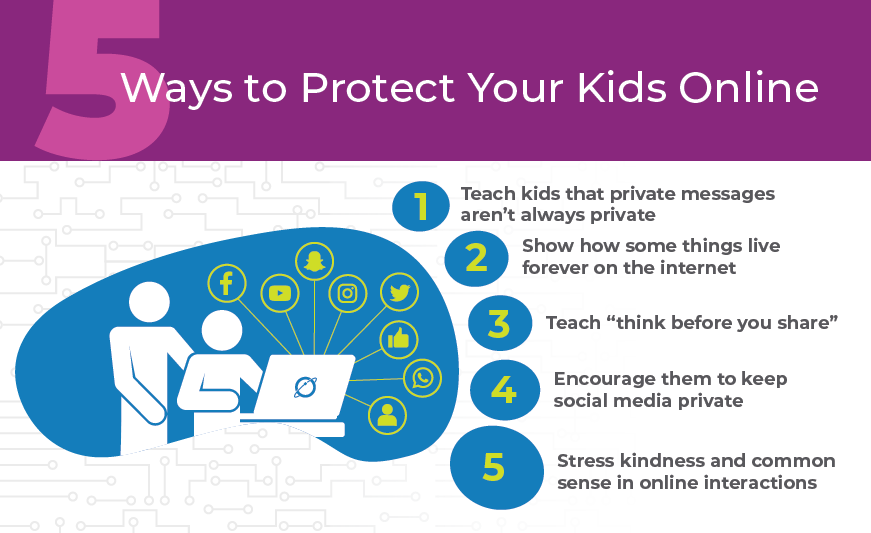What is a Digital Footprint?: 5 Ways to Protect Your Kids Online
As a parent, you’re responsible for teaching your child so many things about the world — from how to tie shoelaces to how to be a good friend. One new thing that parents in the past never had to deal with is how to navigate the world as a child when it’s filled with technology, the internet, and social media.
Cellphones and tablets open up a world of possibility, learning, and entertainment, but they also pose new risks. What your child posts and says online — from Snapchat photos to comments in shared Google Docs — has the potential to be seen by thousands of people in a matter of seconds. Years down the line, these posts may be found by potential employers or loved ones.
Personal information that exists online is called a digital footprint. (It’s similar to a carbon footprint, which estimates the impact an individual has on the environment.) As kids are starting their online lives younger and younger, their corresponding footprints are growing, too. Here are five ways to talk to your kid about digital footprints and make sure they leave a positive reflection of their activities.
Explain That Private Messages Aren’t Always Private
Many kids think that “disappearing messages” — the fleeting kind you find on Snapchat and Instagram — are safe to send because they don’t stick around for longer than a few seconds. Unfortunately, this isn’t always true. Screenshots can be taken of messages and shared instantly. Phones can be taken or stolen and used by other people. Messages can be accidentally sent to the wrong person. The possibility of private messages being shared is actually very high and could result in embarrassment, anger, shame, or even trouble.
Show How Some Things Live Forever on the Internet
The internet in some ways is basically a big news repository. By the time your child graduates from high school, there may be a dozen ways their name can pop up in a quick Google search. Swim meet results, spelling bee awards, even old websites or YouTube videos made for school projects — they all remain available.

Most may be harmless digital milestones, but think about other things you wouldn’t want a search engine to reveal: trouble at school, embarrassing photos, criminal activity, and more. Negative results like these can come back to haunt a person years or even decades down the line — and there’s nothing you can do about it.
Teach “Think Before You Share”
When a kid decides to share a photo that’s probably better left in their camera roll, they aren’t necessarily thinking it through for potential long-term consequences. Their prefrontal cortexes don’t stop developing until they’re well into their 20s, and modern technology enables impulsive behavior in a near-unparalleled way for young people. For example, if you took a photo of someone underage consuming alcohol at a party in 1979, you’d have to wait till the film roll was full, take it the next day to get developed, then bring the photos to school on Monday to show people. And even then, its reach was limited by how many people you showed it to — not how many people checked Instagram that day.
Encourage Them to Keep Social Media Private
Even if your child follows all of the above advice, there are still ways their digital activity can leave a larger footprint than they intended. Public profiles on apps like TikTok, Instagram, Pinterest, and Facebook allow anyone on the internet to see photos or videos that span years back, read captions from forever ago, and even see who mutual friends are. While some of these may be harmless, scammers or online predators may use this personal information to take advantage of a child.
Stress Kindness and Common Sense in Online Interactions
Instantaneous sharing ability, potentially impulsive decision-making, and 24/7 internet access can all add up to a recipe for trouble when it comes to a child’s digital footprint. But one thing your kid can always control is how they present themselves online. If your child tries to always communicate with kindness and common sense — even if someone does take a screenshot of a text, direct message (DM), or social media comment — there’s a lot less to be worried about.
Cyberbullying, harassment, and trolling are all too common in today’s world, and taking care of your kid’s digital footprint can be a challenge. If you’re concerned about what your child is doing on the internet, consider a parental control app that can alert you to potential issues. Help your child choose the high road whenever they can, and be sure to have regular conversations with them about their online activities. No matter what, make sure they have a soft place to land — growing up in the digital age can be hard for them, too.